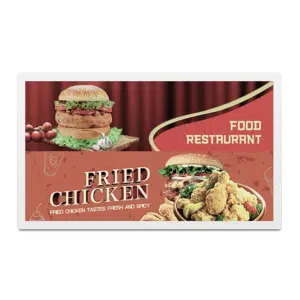Electronic Paper Displays in Education and Beyond
Electronic Paper Displays in Education and Beyond
Blog Article
Display engineering is now an intrinsic element of our day-to-day lives, appearing in sets from smartphones and e-readers to large-scale promotion panels. Among the diverse array of large E ink display, OLED (Organic Light-Emitting Diodes), and LED (Light-Emitting Diodes) have appeared as some of the very generally mentioned options. While every type acts a unique distinctive purpose, their differences in characteristics, effectiveness, and use instances cause them to become suited to certain applications. Let's have a closer go through the key features of the display technologies.
Electronic Paper displays (ePaper)
Electronic Paper displays, also called ePaper or Electronic Ink displays, are created to mimic the look and readability of old-fashioned Ink on paper. This technology uses tiny microcapsules containing charged black and bright contaminants halted in a definite fluid. When an electric subject is applied, the particles go on to either side of the capsule, creating a visible image. The image stays static till another electrical field is used, making it perfect for presenting text-based content such as for instance publications, papers, and e-readers.

One of the main features of ePaper displays is their minimal power consumption. Unlike old-fashioned LCD
Knowledge Electronic Paper displays
An electric Paper display (ePaper) mimics the look of Ink on paper. Unlike conventional screens, ePaper relies on their capability to reflect surrounding mild rather than emitting their own. This engineering not just decreases attention strain but also provides unmatched readability in sunlight, making it well suited for e-readers and electronic signage solutions.
One standout feature of ePaper displays is their extremely low power consumption. Because they simply use energy when changing material, ePaper displays are extremely successful and suitable for battery-powered devices. But, their refresh prices are slower in comparison to OLED and LED displays, limiting their applicability to fixed or minimally vibrant content.
OLED displays
OLED displays are noted for their spectacular aesthetic quality, providing vivid colors, strong blacks, and exceptional contrast. Each pixel within an OLED display emits a unique gentle, removing the requirement for a backlight. That not only allows for leaner, more lightweight patterns but additionally effects in greater energy performance in comparison to LED in certain scenarios.
One important advantageous asset of OLED displays is their flexibility. They may be produced in bent or collapsible styles, making them common in cutting-edge smartphones and wearable devices. However, OLED displays come with difficulties, such as for example susceptibility to burn-in and shorter lifespans in comparison to different technologies.
LED displays
LED displays, the most common of the three, depend on a backlit system to gentle their pixels. While not as visually striking as OLED E ink signage, LEDs are extremely tough, long-lasting, and cost-effective. These features make them ideal for a wider array of purposes, including TVs, computer monitors, and outside advertising.
LED displays generally conduct effectively with regards to brightness, creating them the ideal choice for situations with large ambient light. However, they are unsuccessful in reaching exactly the same deep comparison and shade accuracy as OLED technology.

Final Comparison
When determining between ePaper, OLED, and LED displays, the decision depends mainly on the intended purpose. For static material like reading or signage, ePaper excels with its reduced energy utilization and large visibility in natural light. OLED shines in purposes where lively colors and mobility are paramount. Meanwhile, LED remains a trusted and cost-efficient alternative for a number of general-purpose needs.
Each display technology delivers something unique to the dining table, ensuring that there's a perfect option for every situation. Knowledge these differences can help consumers and companies produce knowledgeable decisions that match their unique display requirements. Report this page